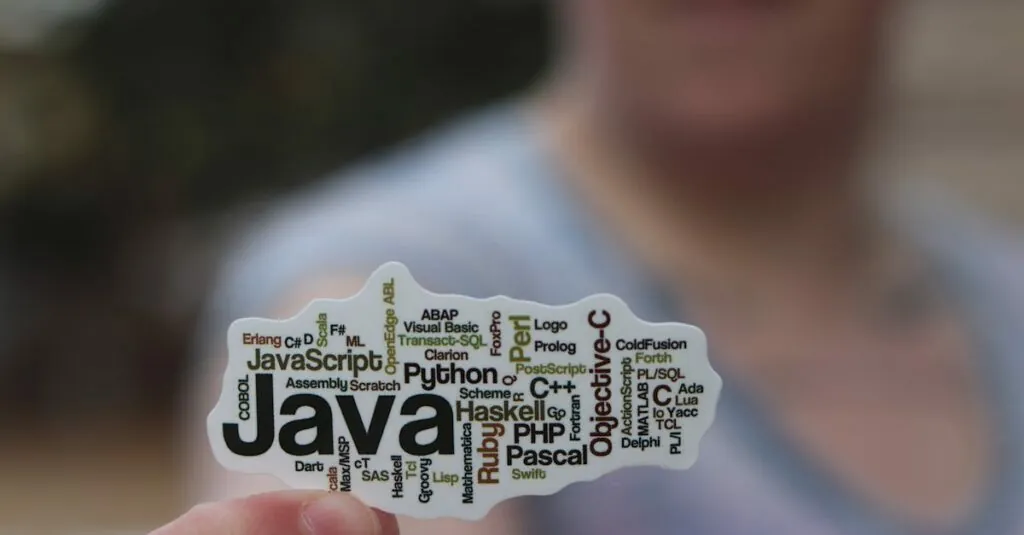Table of Contents
ToggleIn a world where coding can feel like deciphering an alien language, Scratch coding tutorials swoop in like a superhero with a cape made of colorful blocks. Designed for beginners of all ages, these tutorials make learning to code as fun as piecing together a jigsaw puzzle—without the frustration of missing pieces.
Overview of Scratch Coding Tutorials
Scratch coding tutorials provide an engaging introduction to programming for beginners. Many resources exist online, allowing learners to explore coding at their own pace. Tutorials often include step-by-step instructions, which help users create projects from simple animations to interactive games.
Various platforms offer comprehensive guides aimed at different age groups. For example, Scratch’s official website features tutorials tailored for younger audiences, while community forums focus on advanced techniques for experienced coders. Each tutorial promotes creativity, encouraging learners to experiment with their coding skills.
Visual programming blocks form the core of Scratch, making the process intuitive for users. By dragging and dropping these blocks, learners build scripts without needing to memorize complex syntax. This structure fosters a deeper understanding of programming concepts like loops, conditionals, and variables.
In addition to tutorials, a wealth of community projects offers inspiration and ideas. Users can remix existing projects to learn from others and innovate. Collaboration is a key aspect of the Scratch community, promoting support and knowledge sharing among users.
Overall, Scratch coding tutorials simplify the entry into programming. They create an enjoyable learning environment, reducing intimidation associated with traditional coding languages. As newcomers engage with Scratch, they develop essential problem-solving skills while having fun.
Benefits of Learning Scratch
Scratch coding tutorials offer numerous advantages, making them an ideal choice for aspiring coders. Learners benefit from an engaging experience that fosters creativity and critical thinking.
Engaging and Fun
Scratch’s design captures attention through colorful visual blocks. This interactive approach turns coding into a game-like experience. Learners enjoy building games, animated stories, and art projects, making coding feel less intimidating. Many users report higher motivation levels because of Scratch’s playful environment. Projects evolve through exploration and experimentation, allowing individuals to learn at their own pace. Sharing creations within the Scratch community adds another layer of excitement, as users can engage with others and receive feedback.
Skill Development
Scratch promotes essential skills beyond coding. Problem-solving emerges as users navigate challenges while creating projects. They develop critical thinking skills through debugging and optimizing their scripts. Additionally, collaboration shines through when learners share projects and ideas with peers. Communication skills improve as they explain their creations to others. Familiarity with programming concepts like loops and conditionals builds a strong foundation for future coding endeavors. Overall, learning Scratch equips individuals with transferable skills applicable in various fields.
Types of Scratch Coding Tutorials
Scratch coding tutorials come in various formats, providing diverse learning styles access to coding concepts. Both video tutorials and written guides offer unique advantages, catering to different preferences.
Video Tutorials
Video tutorials offer a dynamic and engaging way to learn Scratch coding. Visual learners benefit from seeing actions performed in real-time, as these tutorials step through the process of creating projects. Many platforms provide these resources, featuring experienced instructors and interactive content. Short, focused clips often emphasize specific topics, like creating animations or games. As a result, learners can pause and replay sections to reinforce understanding. Channels on platforms such as YouTube often host a rich variety of Scratch tutorials, making it easy to find content tailored to different levels of expertise. By following along visually, learners develop coding skills while enjoying the creativity inherent in Scratch.
Written Guides
Written guides present detailed instructions for those who prefer a structured approach to learning Scratch coding. These resources often include clear step-by-step explanations and screenshots, ensuring that users grasp concepts easily. Many websites compile extensive libraries of tutorials, catering to various project types, including basic animations and complex games. Users can reference specific sections, allowing them to navigate the material at their own pace. Additionally, written guides often contain helpful tips, coding best practices, and troubleshooting advice, promoting a comprehensive understanding of Scratch. Learners appreciate the ability to highlight sections for review, enabling efficient study sessions tailored to their unique needs.
Key Features of Effective Tutorials
Effective Scratch coding tutorials share several key features that enhance the learning experience. These characteristics engage learners and facilitate a comprehensive understanding of coding concepts.
Clear Instructions
Clarity plays a crucial role in effective tutorials. Step-by-step guidance helps learners grasp complex programming ideas without feeling overwhelmed. Each instruction must focus on a specific action, reducing the potential for confusion. Visual aids like screenshots or diagrams further support understanding. Including examples of finished projects illustrates what learners can achieve, motivating them to experiment. Also, clear language ensures accessibility for all ages. These elements combined create a straightforward learning pathway for beginners navigating Scratch.
Interactive Projects
Interactive projects significantly elevate the learning experience. Learners gain hands-on experience by engaging with coding challenges and creating their own unique projects. Tutorials that encourage experimentation foster creativity and problem-solving skills. Incorporating mini-projects throughout the learning process allows instant application of new concepts. In addition, collaboration on projects encourages peer feedback, enhancing community engagement. When tutorials provide diverse project ideas, learners remain motivated and curious, exploring the full potential of Scratch’s capabilities. These interactive experiences transform coding from a theoretical exercise into a dynamic, enjoyable journey.
Popular Platforms for Scratch Coding Tutorials
Many platforms provide high-quality Scratch coding tutorials tailored for various learners.
Scratch’s Official Website offers a range of free tutorials designed for all ages and skill levels. Users access interactive guides that encourage hands-on learning through projects including animations and games.
YouTube hosts numerous channels dedicated to Scratch coding. Creators like Code Club and The Coding Train present engaging video tutorials, helping visual learners follow along easily.
Khan Academy features coding lessons that incorporate Scratch. The structure supports learners with exercises that reinforce programming concepts, ensuring users build a solid foundation.
Coursera provides comprehensive courses involving Scratch. Instructors guide learners through projects while introducing programming fundamentals. Enrolled students receive feedback based on their progress, enhancing the overall experience.
Code.org offers a user-friendly interface for Scratch tutorials. Their interactive lessons encourage experimentation, making complex coding concepts approachable and fun for beginners.
edX includes university-developed courses utilizing Scratch as a teaching tool. Content targets students interested in exploring programming, fostering a deeper understanding of essential concepts while encouraging collaboration.
Tynker presents avenues for Scratch coding tutorials focused on engaging gameplay. Users learn to create their own games through guided projects, enhancing creativity and problem-solving skills.
Platforms like these create vibrant learning communities. Students share projects, seek help, and inspire one another, enriching the overall Scratch coding experience.
Scratch coding tutorials serve as an invaluable resource for anyone looking to dive into the world of programming. Their engaging and user-friendly approach makes coding accessible to learners of all ages. By utilizing various formats like video and written guides, these tutorials cater to different learning preferences and enhance the overall experience.
The supportive Scratch community further enriches this journey, providing inspiration and collaboration opportunities. As learners create their projects and share their ideas, they not only develop coding skills but also foster essential problem-solving and critical thinking abilities. Embracing Scratch coding tutorials opens the door to creativity and innovation, paving the way for a bright future in technology.







